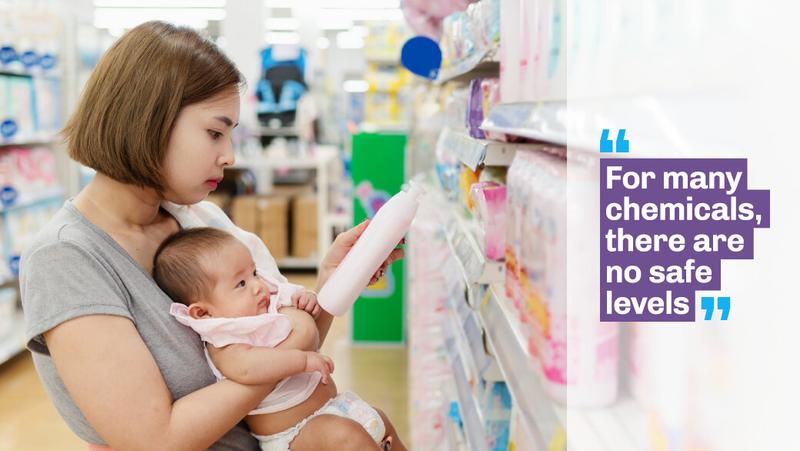You’re picking up face cleanser at the supermarket. There are five or six to choose from.
How do you decide which one to buy? A brand you’ve used in the past? The cheapest? The best smelling? The most natural?
Maybe you read the label. But you’d need several degrees in science to understand that!
One thing you likely take for granted is that the products on the shelf are safe. There can’t be toxic chemicals on the market…right? Doesn’t the government keep us safe?
Unfortunately, this isn’t the case. To understand why, you need to know a little bit about the study of toxic chemicals, known as “toxicology.â€
Traditional Toxicology
To test if a chemical is toxic, researchers give it to animals, mainly mice or rats. It is given in pretty high amounts. Usually way higher than you’d ever encounter in day to day life.
Then they look at the mouse or rat for any bad effects, namely death, tumors, enlarged livers, etc. These effects are known as “gross†effects.
Yes, they can be pretty gross… but in this case “gross†means visible, obvious things, like tumors or death. NOT invisible problems or diseases like heart disease, infertility, or blood sugar levels.
Then toxicologists make a BIG assumption. They assume that the more chemical there is, the worse the effects are. And the less of a chemical, the less bad effects.
Let’s look at this idea on a graph. Here we have rats given 4 amounts of Chemical X: 0 grams, 1 gram, 10 grams, and 100 grams.
The researchers found that the more chemical a rat gets, the more tumors they have. In this case, there are very few tumors at 1 gram.

If you connect the dots in a straight line, you can assume that a small amount of the chemical, say 0.001 grams (the red dot), would have very little effect:
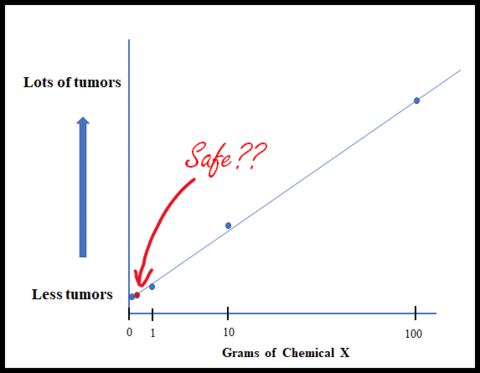
This is done in traditional toxicology. Effects are looked at to find the safest level tested. Then, a researcher or law-maker picks an amount that is many times (maybe 100x) lower than that level. This is the level that is considered safe.
This is how the government and companies test how toxic a chemical is.
But the “safe†level is never even tested!
The Problems with Traditional Toxicology
There are some big problems with this approach:
1. Mice and Rats are Not Humans!
It can be unethical to test on humans. But it is also true that mice and rats are not a great substitute for human health. We have discussed this in detail in another post–check it out!
2. Small Amounts Can Have Big Effects
If we go back to our previous graph, we remember that the “safe†amount of chemical is not tested.
Can we assume that the line we drew is correct? That it stays straight?
The answer is a big fat NO.
Let’s zoom in on the untested area, between 0 grams and 1 gram:
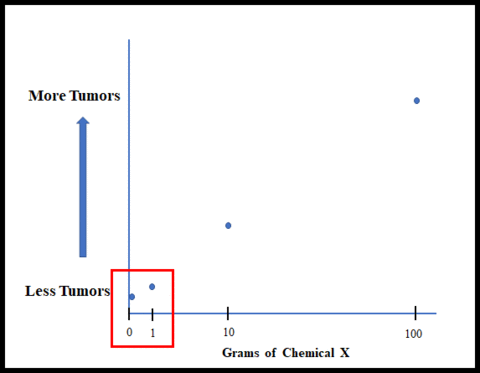
This is done in traditional toxicology. Effects are looked at to find the safest level tested. Then, a researcher or law-maker picks an amount that is many times (maybe 100x) lower than that level. This is the level that is considered safe.
We know from many scientific studies, where lower amounts of chemicals were actually tested, that this line might not be straight.
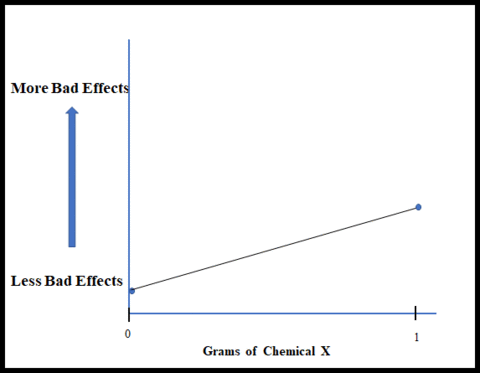
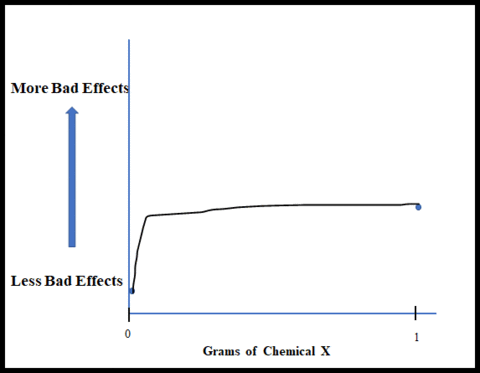
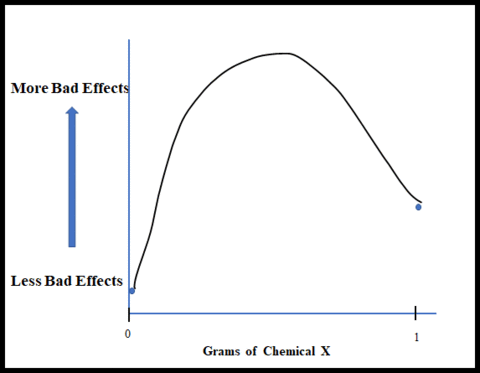
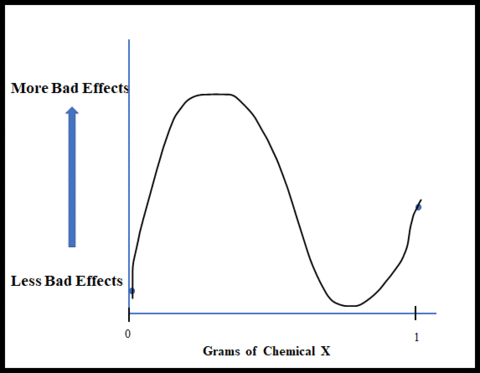
In other words, tiny amounts of chemicals may actually be the same or worse than larger amounts!
The problem is, low amounts are not often tested. And when these “non-linear†responses are found, they may be brushed off as “anomalies.â€
These low amounts are what we would typically encounter in our products!
3. Every Day Health Effects Are Not Tested
Getting tumors and/or dying from a chemical is not ideal. So it is good that these effects are tested. But there are also many other health effects that chemical exposures can cause.
These include:
- Obesity
- Diabetes
- Allergies
- Infertility
- Heart disease
- Brain development in children (i.e. ADHD, Autism)
These more subtle, long term effects. They are usually not studied in traditional toxicology. And many of these effects occur at low amounts of exposure. The same amounts you would encounter day to day in an item off the shelf.
Traditional testing is what is used by the government to determine “safe†levels of chemicals on your supermarket shelf.
What the heck, right?? There has to be a better way.
The New Toxicology
Small amounts of chemicals can have big effects. There have been hundreds of studies showing this. These studies follow the principles of a newer form of toxicology.
These studies test very low amounts of chemicals. Scientists expect to see the non-linear responses as illustrated on the graphs above. They observe how chemicals affect humans in the real world. And they compare animal and human studies to find answers.
They also understand that people are exposed to hundreds of chemicals every day, all at the same time. These chemicals can be even worse in mixtures than on their own.
For certain well-studied chemicals, such as BPA, there have been bad effects at the lowest amounts tested.
Is No Amount Safe?
This new toxicology has led many scientists to advise that, for many chemicals, there are no safe levels.Â
They believe that government regulators should try to reduce chemical exposures as much as possible.
What Can I do to Reduce Exposures?
The current government system is not doing a whole lot to protect us from everyday exposures. Chemicals in products may not be safe. However, as consumers, we are not powerless.
How can you protect yourself and your family? Start with these steps:
- Reduce plastic use, especially in food prep and storage
- Avoid processed and canned foods
- Avoid cash register receipts
- Eat organically when possible (check out this super cool guide!)
- Vote with your wallet by buying natural products. Check out our list of Approved Products
- Support modernized government testing
Get yourself tested to identify exposures and eliminate them
Have questions about toxic chemicals and your health? Contact Million Marker!
Jenna Hua, RD, MPH, PhD, is the founder of Million Marker, a service for people to measure personal exposure to everyday environmental chemicals in their body. Jenna is a registered dietitian and environmental health scientist by training, Jenna’s past research has focused on how our surrounding environment impacts our behaviors and health. An ardent believer in disease prevention, she wants to provide personalized preventive strategies to everyone to lead a healthier life.
Link to Original Post:Â https://www.millionmarker.com/blog/why-safe-chemicals-may-actually-be-harmful
